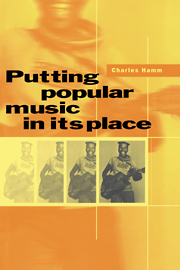Book contents
- Frontmatter
- Contents
- Acknowledgements
- Preface
- 1 Modernist narratives and popular music
- 2 Rock and the facts of life
- 3 Changing patterns in society and music: the US since World War II
- 4 “If I Were a Voice”: or, The Hutchinson Family and popular song as political and social protest
- 5 Some thoughts on the measurement of popularity in music
- 6 Elvis, a review
- 7 Home cooking and American soul in black South African popular music
- 8 Rock ‘n’ roll in a very strange society
- 9 African-American music, South Africa, and apartheid
- 10 “The constant companion of man”: Separate Development, Radio Bantu, and music
- 11 Privileging the moment of reception: music and radio in South Africa
- 12 Music and radio in the People's Republic of China
- 13 Towards a new reading of Gershwin
- 14 A blues for the ages
- 15 Graceland revisited
- 16 Dvořák in America: nationalism, racism, and national race
- 17 The last minstrel show?
- 18 The Role of Rock, a review
- 19 Genre, performance, and ideology in the early songs of Irving Berlin
- 20 Epilogue: John Cage revisited
- Index
8 - Rock ‘n’ roll in a very strange society
Published online by Cambridge University Press: 05 February 2012
- Frontmatter
- Contents
- Acknowledgements
- Preface
- 1 Modernist narratives and popular music
- 2 Rock and the facts of life
- 3 Changing patterns in society and music: the US since World War II
- 4 “If I Were a Voice”: or, The Hutchinson Family and popular song as political and social protest
- 5 Some thoughts on the measurement of popularity in music
- 6 Elvis, a review
- 7 Home cooking and American soul in black South African popular music
- 8 Rock ‘n’ roll in a very strange society
- 9 African-American music, South Africa, and apartheid
- 10 “The constant companion of man”: Separate Development, Radio Bantu, and music
- 11 Privileging the moment of reception: music and radio in South Africa
- 12 Music and radio in the People's Republic of China
- 13 Towards a new reading of Gershwin
- 14 A blues for the ages
- 15 Graceland revisited
- 16 Dvořák in America: nationalism, racism, and national race
- 17 The last minstrel show?
- 18 The Role of Rock, a review
- 19 Genre, performance, and ideology in the early songs of Irving Berlin
- 20 Epilogue: John Cage revisited
- Index
Summary
On a third trip to South Africa, in the winter and spring of 1983–4, I continued to investigate the complex interrelations among popular music, the black population, the music industry, and the government's media strategies. Gaining access to several large repositories of recordings by black performers, I listened to and taped hundreds of pieces recorded from the 1930s through to the 1970s, and combed newspapers, popular journals, government publications, and the scholarly literature for contemporary accounts of musical life during these years. Travelling to every section of the country, including each of the so-called homelands, and to Namibia, I listened to and recorded samples of the various “vernacular” services of the South African Broadcasting Corporation. Other scholars had begun to address this music as well, and I benefited particularly from the work of David B. Coplan and Veit Erlmann.
But I still didn't have sufficient control of the complex material to consider a major publication; so I began planning another, much longer research trip to the region. In the meanwhile, since no study of popular music in South Africa could ignore the impact of foreign and particularly American music and musicians, I undertook the following case study of the reception of a new musical genre in a culture other than its own.
- Type
- Chapter
- Information
- Putting Popular Music in its Place , pp. 150 - 166Publisher: Cambridge University PressPrint publication year: 1995

